Free Online Productivity Tools
i2Speak
i2Symbol
i2OCR
iTex2Img
iWeb2Print
iWeb2Shot
i2Type
iPdf2Split
iPdf2Merge
i2Bopomofo
i2Arabic
i2Style
i2Image
i2PDF
iLatex2Rtf
Sci2ools
ICDM
2007
IEEE
2007
IEEE
Characterizing RNA Secondary-Structure Features and Their Effects on Splice-Site Prediction
— RNA molecules are distinguished by their sequence composition and by their three-dimensional shape, called the secondary structure. The secondary structure of a pre-mRNA sequence may have a strong influence on gene splicing. In our previous work, we showed that a splice-site model employing sequence features built using our feature generation algorithm was very effective in predicting splice sites. The generated sequence features also contained biologically relevant features. In this paper, we extend the feature generation algorithm to construct secondary-structure features. These features capture the nucleotide pairing tendency in the splice-site neighborhood. We extend the splice-site model to include both pre-mRNA sequence and structure characteristics. The new model significantly outperforms the sequence-based features model. The identified secondary-structure features capture biologically relevant signals such as splicing silencers. We also found these signals to prefer spe...
Related Content
| Added | 03 Jun 2010 |
| Updated | 03 Jun 2010 |
| Type | Conference |
| Year | 2007 |
| Where | ICDM |
| Authors | Rezarta Islamaj Dogan, Lise Getoor, W. John Wilbur |
Comments (0)

